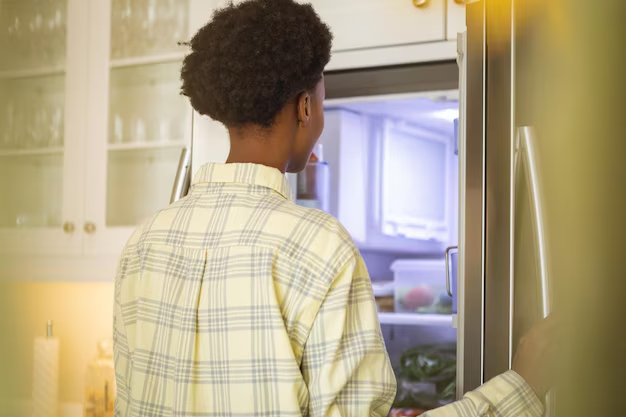What's the Ideal Temperature for Your Refrigerator? Let's Dive In!
When it comes to keeping your food fresh and safe, setting your refrigerator to the right temperature is crucial. However, not everyone knows exactly what that temperature should be. Whether you're a new homeowner, a first-time renter, or simply someone looking to optimize food storage, this comprehensive guide aims to clear up any confusion about the perfect refrigerator temperature.
🌡️ Why Is the Right Refrigerator Temperature Important?
Setting the correct temperature in your refrigerator is vital for a number of reasons. Food Safety is a primary concern; keeping food at the wrong temperature can encourage bacteria growth, which can lead to foodborne illnesses. Another reason to set the correct temperature is Food Freshness. Optimizing the temperature ensures that your produce, dairy, and other perishables have the longest possible shelf life.
The Goldilocks Zone: Just Right!
According to experts, the ideal refrigerator temperature should be set between 35°F and 38°F (1.7°C to 3.3°C). This range is commonly accepted as the 'sweet spot' for keeping food safe without freezing it. For the freezer, aim for a temperature below 0°F (-18°C) to keep frozen foods solid and long-lasting.
🧊 How to Test Your Refrigerator's Temperature
Knowing the ideal temperature is just the first step. Here’s how to ensure your refrigerator meets this standard:
Use a Refrigerator Thermometer: Invest in a reliable refrigerator thermometer to gauge the temperature accurately.
Check Both Sections: Place the thermometer in a glass of water in the central part of the main compartment for a clear reading. For the freezer, place the thermometer between items, away from the walls.
Wait and Record: Check the thermometer after 24 hours for an accurate reading, and adjust the settings as necessary.
Pro Tip: Allow for Calibration 🙌
Refrigerators often have temperature settings that range from "colder" to "warmest," but these are not always perfectly calibrated. Whenever you adjust the temperature, remember to check after 24 hours to ensure a consistent reading.
🚪 Factors Affecting Your Refrigerator's Temperature
Did you know several external factors can impact your fridge's performance? It's essential to recognize these for optimal settings:
Room Temperature: Appliances in warmer kitchens work harder, potentially affecting internal temperatures.
Placement: Avoid placing the fridge near heat sources like ovens or in direct sunlight.
Loading: Overloading or underloading can also disrupt air circulation, impacting temperature.
Door Usage: Frequent opening of the doors affects the cooling cycle. Practice quick checks to maintain a stable environment.
🛠️ Troubleshooting Common Issues
Even with the perfect setup, things can go awry. Here are some common problems and their solutions:
1. Inconsistent Temperature
- Solution: Ensure the door seals are tight. Cracks or wear can let cold air escape, leading to fluctuating temperatures.
2. Freezer Burn
- Solution: Lower the freezer temperature, or check for foreign objects blocking vents, which could compromise the airflow inside.
3. Food Spoilage Despite Correct Temperature
- Solution: Reevaluate food storage practices, such as not storing perishables in the door, where temperatures tend to fluctuate the most.
🥬 How to Optimize Storage for Maximum Efficiency
Knowing the ideal temperature is crucial, but effective food storage within the fridge can further prolong freshness:
Dairy and Eggs: Place in the coldest part of the refrigerator, usually the bottom shelf.
Produce: Use the crisper drawers designed to maintain a different humidity level suitable for fruits and vegetables.
Meat and Fish: Store these on the bottom shelf or a dedicated meat compartment to prevent juices from contaminating other foods.
Leftovers and Ready-to-Eat Foods: Keep at eye level to ensure they are consumed in time.
⚠️ Quick Tips and Summary
To make things even clearer, here is a concise list of practical tips and key takeaways:
- 🥶 Ideal Temperature: 35°F to 38°F (1.7°C to 3.3°C) for the fridge; 0°F (-18°C) for the freezer.
- 🔍 Monitor Regularly: Use a thermometer for precise readings.
- 🚪 Mind the Doors: Quick openings maintain a consistent temperature.
- 🍏 Organize Wisely: Use zones and drawers for specific food types.
- 📍 Check Placement: Ensure the fridge is in a cool, shaded spot for best performance.
- 🛠️ Inspect Regularly: Seals and coils should be checked to avoid performance issues.
Closing Thought: Consistency Is Key to Freshness
Understanding and managing your refrigerator's temperature is a critical step in ensuring food safety and maximizing the longevity of your groceries. By taking regular checks, making adjustments as needed, and organizing your fridge strategically, you maintain the ideal environment for your perishables. As with any appliance, occasional maintenance and mindful use are your best tools to achieve an efficient and effective refrigeration environment.
Armed with this knowledge, you'll be better prepared to maintain the freshness of your food and the safety of your household. Making these adjustments may seem small, but they can have a significant impact on both your health and your grocery bill. Happy refrigerating! 🥗
